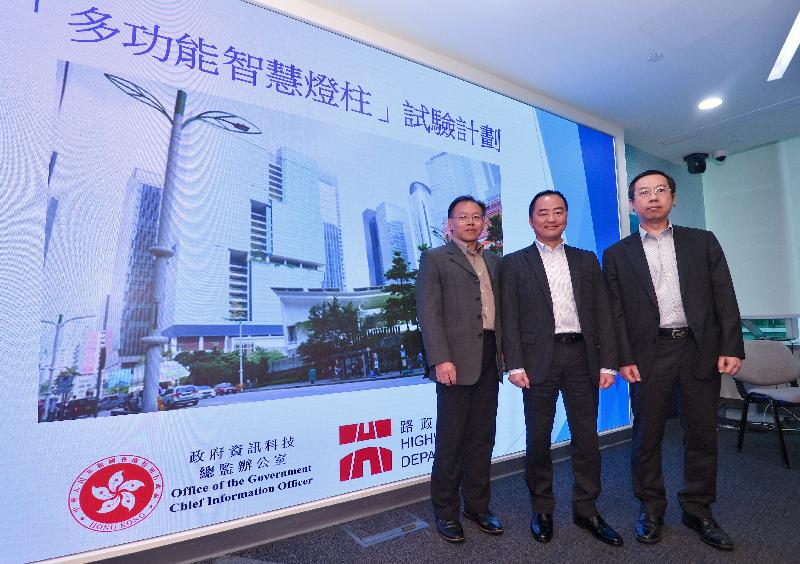A closer look at technologies applied in smart lampposts (with photos/video)
****************************************************************************
Key points about smart lampposts are:
- Provision is made for mobile network operators to install 5G base stations to facilitate the future development of fifth generation (5G) mobile network services in Hong Kong and to offer free Wi-Fi services.
- Smart devices including traffic detectors, panoramic cameras, meteorological sensors and air quality sensors are installed to collect three types of real-time city data, including meteorological data, air quality data and traffic snapshot images with a view to enhancing city and traffic management.
- All data collected will be uploaded as open data to the Public Sector Information (PSI) Portal (data.gov.hk) for sharing and to encourage the development of more innovation applications, thus driving smart city development in Hong Kong.
- Appropriate privacy protection measures are in place, e.g. cameras are set to face and take pictures of public areas only, and notices are put up at prominent locations. Currently, the cameras only take snapshots of road conditions.
- The traffic snapshot images are taken every two minutes. The process of lowering resolution of images is carried out in the lampposts. The images will be deleted immediately after transmission to the PSI Portal.
- The images and videos recorded by the surveillance cameras will only be used by the Transport Department (TD) and the Environmental Protection Department (EPD) for monitoring traffic conditions and assisting law enforcement work against illegal dumping of construction waste. Relevant panels of the Legislative Council (LegCo) were consulted last year. The LegCo panels supported the two specific applications.
- The lampposts do not carry any facial recognition function. Images taken will not be sent to any third party for facial recognition applications.
- The Bluetooth traffic detectors will extract only part of the digits in Media Access Control (MAC) address for matching purposes, in order to assess the average traffic speed and travel time of vehicles passing by. The MAC address data will be deleted from the system right after completion of analytics.
- The community has always had great concerns about privacy. The OGCIO has been in close contact with the Privacy Commissioner for Personal Data since the designing stage of the lampposts to ensure all applications fully comply with the Personal Data (Privacy) Ordinance.
- The Bluetooth transmitters are only used to offer positioning services such as providing information to citizens and visitors on public facilities nearby.
- The radio frequency identification (RFID) technology used in smart lampposts are developed by the LSCM. It is merely an electronic tag for transmitting signals. The tag does not carry any function of collecting data and cannot read any data in other devices. One of the applications is to pair up with the Blind Cane Navigation System and provide navigation for the visually impaired.
In view of the public concern over some of the applications which may touch on privacy, some functions of the lampposts will not be activated at this stage. These include the monitoring of illegal dumping with the aid of cameras located near black spots by the EPD, the assessment of road use by different types of vehicles enabled by Bluetooth traffic detectors and cameras collecting car plate numbers by the TD. The OGCIO will conduct more extensive consultation and will only activate the relevant functions upon public consensus.
The Multi-functional Smart Lampposts pilot scheme is a three-year programme in which some 400 smart lampposts will be installed in phases in four districts with higher pedestrian and traffic flow, namely Central/Admiralty, Causeway Bay/Wan Chai, Tsim Sha Tsui and Kwun Tong/Kai Tak Development Area, with a view to promoting smart city development in Hong Kong and supporting 5G mobile network implementation. Since the end of June, 50 smart lampposts have been put in place on Sheung Yuet Road in Kowloon Bay, Shing Kai Road in Kai Tak and in the Kwun Tong city centre to collect various types of real-time city data such as meteorological data, air quality data and traffic flow. The data collected will be released to the public as open data via data.gov.hk for development of innovative applications.
Ends/Tuesday, July 16, 2019
Issued at HKT 18:35
Issued at HKT 18:35
NNNN
Photo
Audio / Video
Technical briefing on smart lampposts
Related Links
OGCIO clarifies online rumour
OGCIO releases locations, functions and equipment list of smart lampposts







